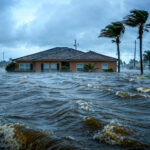The global community continues to deal with known challenges such as the pandemic, the war in Ukraine, economic turmoil and failing trust in established social institutions. But a report from Swiss Re reminds re/insurers there are new emerging risks on the horizon that could materialize.
“This year’s emerging risks arise from climate change and the transition to a low-carbon economy, real and hyped technological disruptions, and increased global uncertainty and risk awareness,” said a commentary accompanying Swiss Re’s SONAR report “New emerging risk insights.”
Swiss Re identified by lines of business the top emerging risk themes that could affect re/insurers:
- Thawing permafrost – accelerating climate, infrastructure and health hazards. This risk poses environmental, property and health risks, and may translate into property and liability claims. (See below for more detailed explanations of these risks).
- Legal tech – is AI rendering justice? Lawyers may utilize “legal tech,” or advances in artificial intelligence (AI) and machine learning (ML), to select cases with highest chances of success. This risk has implications for casualty exposures.
- Quantum computing – a threat before an opportunity. With rapid development of quantum computing (QC) capacity, re/insurers face new threats to data security, which could affect property, specialty and casualty lines as well as operations and assets and financial markets.
- Challenges in construction – raw material shortages and price increases.There is concern that inflationary pressures and raw material scarcity could affect quality and durability of buildings, posing risks to property, specialty and casualty lines.
- Eroding trust – new worries for public health. Swiss Re said life & health re/insurers could be affected by growing mistrust in public health officials and medical professionals, which “fosters harmful behavior and increases the risk of higher morbidity and mortality, particularly in future health crises.”
Thawing Permafrost
Diving into each of these topics in turn, Swiss Re said permafrost has been thawing at an increased speed over the past decades in high latitudes and mountainous regions. “This poses environmental, property and health risks, and may translate into property and liability claims, and also higher costs in L&H business,” said the report.
“Damage to property or infrastructure due to thawing permafrost can increase claims in property and engineering. This is also relevant with respect to the liability of engineers and architects involved in the planning, and public sector entities supporting or building infrastructure in permafrost zones or in areas exposed to risks associated with thawing of permafrost (e.g., rockfalls),” the report added.
Swiss Re said there could also be an increase in liability claims against projects that accelerate thawing of permafrost.
Also, health claims could affect L&H insurers as a result of illness caused by pathogens and pollutants released by thawing permafrost. “Thawing permafrost also poses risk to health, of both humans and animals. It can release pathogens previously trapped in frozen ground, such as anthrax. Thawing also causes limestone deposits to release toxic substances, such as mercury and radon. Mercury poisoning of water sources has been reported in permafrost regions.”
Legal Tech
Legal tech, which employs AI and ML, could have a big direct impact on insurers if lawyers use legal tech systems “to zero in on those lawsuits/cases with most chance of success,” said the report, noting that this could also lead to a significant rise in claims loads.
The other potential impacts of legal tech include:
- A potential rise in liability cases in situations where AI software produces incorrect outcomes. This includes big law firms that may be held liable for the services they offer while using these types of technologies (e.g., in accounting, taxes, licensing, etc).
- Lawyers may decide to focus on class action cases with a higher chance of winning larger awards, which could lead to priorization of economic success over justice and also an overall increase in the claims load for insurers.
- Increased claims load could come from low-value claims as efficiency gains from legal tech may lower legal costs for individual cases. “Potential lines of business impact could be, for instance, motor liability (car accidents), employer’s liability/workers compensation (workplace accidents),” said Swiss Re.
On a more positive note, Swiss Re said, legal tech can benefit insurance operations by helping to mitigate mistakes and fraud, while identifying high-liability risk or high-exposure cases.
Quantum Computing
Swiss Re describes quantum computing as a technology that can solve problems too complex for classical computers. “Insurers and other financial service providers will benefit from the accelerated processing power, high-speed data pattern recognition and elevated machine learning that QC promises,” said Swiss Re. “For insurers, QC opens unprecedented opportunities for simulation and modelling.”
Along with the benefits, however, there will be new threats to data security “which from the insurer’s perspective will likely outpace any benefits for the foreseeable future,” said the report.
While the first models are on the market, the report noted that a fully fledged quantum leap is still a few years off.
“And worryingly, before companies can profit from broad commercial application, QC will likely mature as a threat to existing IT-security protocols – particularly as a yet unseen force that can hack standard encryption keys used in online communications and data transfer,” the report continued.
Here are some of the potential impacts of QC identified by Swiss Re:
- It may take longer than anticipated for business-relevant applications to become available, and some could even fail, which translates into strategic, investment and operational risk.
- QC raises the potential for large-scale attacks on data security in general, as well as for targeted attacks on quantum research and development organizations. Further, cyber and property insurance losses could be triggered from attacks on insureds.
- Should standard encryption keys for Internet communication, digital banking and electronic commerce be hacked, there could be cyber insurance and business interruption claims.
- Insurance operations also could be affected if an insurer or one of its third-party suppliers experiences a data privacy breach, which could lead to reputational damage and financial losses. In addition, the transition to safer (post-quantum) data encryption will be time consuming and expensive.
Lower Construction Quality
Scarcity of raw materials due to supply chain disruptions and rising wages are leading to high inflation in the construction sector, which could see builders “cut corners,” leading to lower construction quality and ultimately higher claims in property and professional indemnity.
The use of less expensive and often inferior materials from a fire and integrity standpoint, the report said, pointing to the example combustible cladding for buildings, which can be visually identical to but far less expensive than non-combustible cladding. “In the event of a fire in a building with combustible cladding, however, the losses can be much higher.”
Swiss Re noted that the risk of unexpectedly high claims is a challenge for long-tail business in particular, such as engineering, where there is a long time lag between premium payment and claims filing.
Eroding Trust
“Trust between large segments of the population and government officials as well as academic experts has been challenged by the pandemic, and the possibility exists that conspiracy theories and alternative views on health and other behaviors will negatively impact societal resilience more broadly,” according to the report.
Here are some of the potential impacts of eroding trust identified by Swiss Re:
- If people refuse treatment, avoid preventative measures, or turn to dubious alternatives for their health conditions, there could be negative consequences on morbidity and mortality.
- Individuals, professionals and organizations providing harmful treatments may face liability claims.
- Longer lasting and more expensive public health crises may result if growing societal divisions hamper effective resolution of public health emergencies.
- In the case of future pandemics, increased excess morbidity and mortality may occur if large portions of the population do not trust guidance from public health authorities, further undermining societal resilience.
About SONAR
The SONAR report, which is celebrating its 10th anniversary, identifies 24 macro trends central to the insurance industry in the areas of “demographic and social environment,” “political and economic environment,” “technological and natural environment,” and “competitive and business environment.”
The report conveys early risk signals from a wide range of insurance-relevant fields, said Swiss Re, explaining that the signals do not reflect entire industry-wide thinking with respect to emerging risks, nor do they necessarily cover the full list of topics currently on Swiss Re’s radar screen.
“Some emerging risks presented in this year’s SONAR report may never materialize, while others may form the basis for future risk pools. Similarly, some of the trends depicted may lose importance, while others may play a growing role in shaping the future business environment.”
SONAR stands for Systematic Observation of Notions Associated with Risk, which is Swiss Re’s process for identifying, assessing and managing emerging risks.
Source: Swiss Re SONAR




















 Soft Market Ahead? The Role of Digital Transformation for E&S Insurers
Soft Market Ahead? The Role of Digital Transformation for E&S Insurers  Auto Insurer Files $450M Fraud RICO Case in NY
Auto Insurer Files $450M Fraud RICO Case in NY  What’s Not Changing in 2025: Homeowners Outlook, Re Retentions
What’s Not Changing in 2025: Homeowners Outlook, Re Retentions  Moody’s: Rising Flood Risks Posing Greater Challenges for Eastern and Southern U.S.
Moody’s: Rising Flood Risks Posing Greater Challenges for Eastern and Southern U.S. 